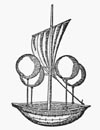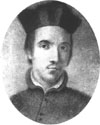The Earliest Efforts
at Flight
The
beginning of humanity’s infatuation with flight is shrouded in legend.
Ancient tales tell of beasts or half-birds flying through the air. Greek
mythology tells the story of Pegasus, a flying horse, and the messenger
god Hermes in his winged sandals flying throughout the world. The Valkyres
of the Norse myths traveled through the air on winged horses. The ancient
Greek myth of Daedalus and Icarus tells the tale of how Daedalus made
wings of wax and feathers so that he and his son Icarus could escape from
captivity. But Icarus flew too close to the sun and his wings melted,
while Daedelus flew too low and crashed into the rocks. Both died in their
attempts to fly.

In Greek mythology,
Icarus flew too close to the sun
Other
legends about flight abound. Another early one tells of King Bladud, who
ruled in Britain in the ninth century B.C.E. Bladud supposedly constructed
a pair of wings with which he proposed to fly. But, according to the monk
Geoffrey of Monmouth in a history of the British kings, Bladud was dashed
to pieces as he landed on top of the Temple of Apollo in the town of Trinovantum.
Another tale recounts the invention of a Greek named Archytas of Tarentum
who was said to have made a wooden bird about four hundred years before
Christ. This bird was powered by steam and supposedly flew about 50 feet
(15 meters).
The
wars of Alexander the Great in the second century B.C.E. were illustrated
in medieval prints showing chariots being pulled through the air by griffins
or other creatures with eagle’s heads and wings and bodies of lions.
In Roman times, numerous reports told of men flying like birds and some
who attempted to fly but fell to their deaths. One story tells of Simon
the Magician who attempted a flight in front of the emperor Nero.

"Flight"
of Simon the Magician in Roman times.
The
Chinese were the first to fly kites sometime during the first millennium
B.C.E. These have been called the world’s first aerial vehicles.
The philosopher Mo Tzu in the fifth century B.C.E. reportedly constructed
a wooden kite that could fly but was wrecked after one day’s tests.
A general in 206 B.C.E. described using a kite for reconnaissance. The
kite was also used for carrying bombs in war as well as for more benign
purposes.
The
Europeans also flew kites, pennons, and other devices based on European
tradition from an early era. They learned to make plane surface kites
from people in the Middle East. In recounting his adventures in the Far
East in the thirteenth century, for example, the explorer Marco Polo described
the binding of a man to a wooden structure—a primitive kite—and
exposing him to the wind so that he was carried aloft.
Muslims
attempted other aerial feats. The first documented parachute flight was
achieved by a Muslim. Around 852, a Moor in Córdoba, Spain, attempted
to use a large piece of cloth to slow his fall when he leapt from a high
structure. A Moorish doctor with wings and feathers attached to his body
made the first glider flight around 875 in Andalusia, Spain. He apparently
flew some distance but injured himself upon landing. Around 1000, a Turk
jumped off the roof of a mosque with two large wooden wings attached to
his body and fell to his death. Another Turk in Constantinople suffered
the same fate when he attempted a jump before Emperor Comnenus in 1162.
Earlier,
in 1010, a monk in Malmsesbury, England, attached artificial wings to
his body and jumped from the top of his abbey to glide to only two broken
legs upon landing. Other tower jumpers suffered death or injuries, while
a few achieved some partial success with their glides.
In
fifteenth-century Italy, the brilliant Italian artist, scientist, and
engineer Leonardo da Vinci, who understood some of the basic principles
of flight as early as the 1480s, was the first to seriously study aerodynamics.
He examined the way birds flew and sketched their wings and muscles in
a flying position. His notebooks were filled with drawings and descriptions
of birds in flight and with models that had wings like birds. Unfortunately,
his ornithopter and helicopter designs could never have left the ground
with them. He, and others of his time, failed to realize that human beings
lacked the necessary muscle power to imitate bird flight with flapping
wings. His works were rediscovered in the 19th century and had little
or no influence on the history of flight technology.

Leonardo's
drawing of a wing.
Almost
four hundred years after Leonardo, French inventor Gustave Trouvé
designed an ornithopter that was powered by an internal combustion engine.
In 1870, Trouvé’s unmanned model successfully flew a distance
of 70 meters in a demonstration before the French Academy of Sciences.
Another Frenchman, Alphonse Pénaud, pioneered the use of rubber
band-powered motors in a small ornithopter built and flown in 1874. Today,
ornithopter designs are still on the minds, as well as the drawing boards,
of adventurous and imaginative people determined to achieve the old dream
of flight with flapping wings.

Francesco
de Lana's design for an aerial ship, 1670.
|
|

Francesco de Lana came up with an idea for an airship carried aloft
by vacuum balls. |
Other
adventurers and experimenters followed. In 1670, a Jesuit priest Francesco
de Lana described a wicker basket that was attached to four large hollow
balls. In his design, the balls were made of a light metal. with all the
air removed from inside. De Lana never built his flying vehicle, but his
scheme received considerable attention, some quite mocking. In 1678, a
French locksmith Besnier was reported to have made several gliding flights,
gliding from a high window in Sablé, between Le Mans and Nantes,
France, to the ground below using cloth wings attached to his shoulders
and to his feet. He moved these wings in imitation of a bird in flight
and reached the ground without injury. In 1709, a Brazilian Jesuit in
Lisbon, Portugal, Laurenço de Gusmão, tried to launch an
aerial vehicle or Passarola, a kind of bird-shaped glider, reportedly
demonstrating it to the Portuguese king. Similar attempts continued for
many decades until George Cayley was able to resolve most of the theoretical
problems of flight in the early nineteenth century.
--Judy
Rumerman
References:
Angelucci,
Enzo and Matricardi, Paolo. World Aircraft: Origins – World War
I. Chicago, Rand McNally and Co., 1975.
Harrison,
James P. Mastering the Sky: A History of Aviation From Ancient Times
to the Present. New York: Sarpedon, 1996.
Scott,
Phil. The Shoulders of Giants: A History of Human Flight to 1919.
Reading, Mass.: Addison-Wesley Publishing Company, 1995.
|
Educational Organization
|
Standard Designation (where applicable)
|
Content of Standard
|
|
International Technology Education Association
|
Standard 10
|
Students will develop an understanding of the role of
invention, innovation, and experimentation in problem solving.
|
|
American Association for the Advancement of Science
|
N/A
|
The early Egyptian, Greek, Chinese, and Arabic cultures
are responsible for many scientific ideas and technological inventions.
|
|



